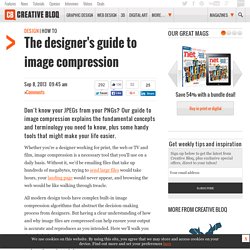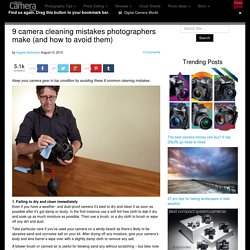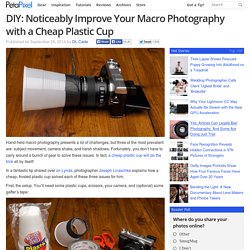

6 simple lighting setups for shooting portraits at home (plus free cheat sheet) A Future Site ▼ Digital Camera World 6 simple lighting setups for shooting portraits at home (plus free cheat sheet) 6 simple lighting setups for shooting portraits at home (plus free cheat sheet) jmeyer | Photography Tips | Portraits | 03/04/2013 01:00am 1 Comment « Previous1234567 6 simple lighting setups: free photography cheat sheet To view the cheat sheet simply click on the infographic for the larger version, or drag and drop it to your desktop.

On the top of the cheat sheet we’ve also included a key that illustrates the type of lighting unit depicted in each of our lighting setups. 10 common camera mistakes every photographer makesSee the light like a pro: everything you were afraid to ask about using natural light Posted on Wednesday, April 3rd, 2013 at 1:00 am under Photography Tips, Portraits. Tags: photography cheat sheet, portrait photography, studio lighting.
Using Your Camera's Histogram to Take Better Digital Photographs - Envato Tuts+ Design & Illustration Tutorial. The histogram is one of the best ways to check for accurate exposure in the camera, and yet it's underused by many photographers.

Use this tutorial to learn to use histograms in-camera and as part of further Photoshop processing. 1. Using Your Camera's Histogram to Take Better Digital Photographs. The designer's guide to image compression. Whether you're a designer working for print, the web or TV and film, image compression is a necessary tool that you'll use on a daily basis.

Without it, we'd be emailing files that take up hundreds of megabytes, trying to send large files would take hours, your landing page would never appear, and browsing the web would be like walking through treacle. All modern design tools have complex built-in image compression algorithms that abstract the decision-making process from designers. But having a clear understanding of how and why image files are compressed can help ensure your output is accurate and reproduces as you intended.
Here we'll walk you through the basic terms and concepts of image compression that all designers need to know, then look at some of the more useful tools on the market to help you out. 01. Once you’ve been working with images for a while, you’ll understand there are two fundamental types of image: bitmap and vector. 02. 03. 04. 05. 06. Lighting Ratios and Incident Metering Demystified. The term "lighting ratio" is a quantitative measure of the difference between two light sources, or the amount of light reflection from the highlight and shadow sides of the face.

A numerical ratio is like a blueprint a builder can follow to construct a building he has never before seen. For example an assistant might be told to set up the studio lights for a "3:1" ratio and know per the convention for portraits that means the key light must be 2x (1 f/stop) brighter than the fill. Graduating a highlight using the Inverse Square Law. Expert photography blogs, tip, techniques, camera reviews - Adorama Learning Center. The Inverse Square Law of Light. A simple explanation by Karl Taylor. Inverse square law (Omgekeerde kwadraten wet) Voor ons fotografen draait alles om het werken met licht.

Het gekozen gebruik van het licht bepaalt voor een groot deel de sfeer van de foto, maar leidt ook de kijker door het beeld. De lichte delen trekken de aandacht terwijl de donkere delen pas later meespelen. Off-Camera Metering with Steve Sint. 9 camera cleaning mistakes photographers make (and how to avoid them) Keep your camera gear in top condition by avoiding these 9 common cleaning mistakes. 1.

Failing to dry and clean immediately Even if you have a weather- and dust-proof camera it’s best to dry and clean it as soon as possible after it’s got damp or dusty. Understand what is Aperture in photographic basic. DIY: Noticeably Improve Your Macro Photography with a Cheap Plastic Cup. Hand-held macro photography presents a lot of challenges, but three of the most prevalent are: subject movement, camera shake, and harsh shadows.

Fortunately, you don’t have to carry around a bunch of gear to solve these issues. In fact, a cheap plastic cup will do the trick all by itself! In a fantastic tip shared over on Lynda, photographer Joseph Linaschke explains how a cheap, frosted plastic cup solved each of these three issues for him. First, the setup. Digital Photography 1 on 1: Episode 57: Rear Curtain Sync: Adorama Photography TV.
100+ Creative Photography Ideas: Techniques, Compositions and Mixed Media Approaches. Students taking high school photography qualifications such as A Level Photography or NCEA Level 3 Photography often search the internet looking for tips, ideas and inspiration.

This article contains well over 100 creative techniques and mixed media approaches that Fine Art / Photography students may wish to use within their work. It showcases student and artist examples along with brief descriptions of the techniques that have been used. Approaches relate specifically to mixed media photography techniques, technical / trick photography ideas and interesting, fun or unique compositional strategies. Note: The creative photography ideas listed in this article should not be explored haphazardly within a Photography course, but rather selected purposefully, if appropriate for your topic or theme.
Nachtfotografie. Luminance: Michael Muller. Zonesysteem. Photographing 2-Dimensional Artwork. Four Flash Photography Basics we must know - Inverse Square Law. Flash Photography Basics, an Introduction The reason to use flash is of course that flash is very bright (and very fast) for easy camera exposure.

In comparison, the brightest light bulbs are dim for photography, not near sunlight bright. Without flash, even well lighted rooms will suffer from long slow shutter speeds, or high ISO, or both. Light bulbs can be fine for still life photography, when a one second shutter is no problem, but which is unacceptable for pictures of people, who tend to move. Flash also allows us to create the lighting, to be like we want it, to place flash wherever we want them, and to be made soft as we might desire, etc. Flash photography is many things. In short summary, the major points, the really big deal about flash, is: The intensity of any near light source (flash or continuous) falls off fast with distance (inverse square law). HDR and Flash for Real Estate Photography. Lights, camera, nostalgia! The rebirth of Studio Harcourt. [Fstoppers Original] What Is Lens Diffraction And When Does Diffraction Happen? If you are like me then you might not always get caught up in some of the super technical aspects of photography.
![[Fstoppers Original] What Is Lens Diffraction And When Does Diffraction Happen?](http://cdn.pearltrees.com/s/pic/th/fstoppers-original-diffraction-95892030)
One aspect of photography I recently investigated was the loss of sharpness caused by Diffraction. Last night while playing with the new Nikon D800 camera I examined lens diffraction and how diffraction can seriously affect the sharpness of your photography. One thing that always blew my mind in science class was when my professors told me light can act both as a particle and as a wave (quantum physics was never my strong suit). Tips for Phone/Tablet Art Photography. Self-portrait by Sebastian Michaels – Click to enlarge How to Hone Your Artistic Skills While Creating Great Images on a Smart Phone or Tablet. Basics of Metering. How to Photograph a chrome faced watch with a reflective body and strap. Disclaimer (yeah this is where I cop out!) This shot was produced merely as an exercise, and not for a client or the watch manufacturer. Honestly – had it been for a client It would of been a re-shoot due to some of the issues I came across. Exposure Compensation.
I believe I have a reasonably secure understanding of exposure – i.e. use and relevance of ISO, aperture and shutter speed – and the purpose of and when to use exposure compensation. Nowadays, I use the histogram to act as a guide to exposure – as I don’t have ‘LiveView’ this is a retrospective action when I review the shot on the back of the camera. Nevertheless, I can see what’s going on and can make another exposure if I believe my first attempt is not right. Exposure Compensation. Exposure compensation. For the first six months of my relationship with my Canon 40D SLR, I did not know a quick way to correct exposure. I would take a photo that was too dark or too light, and I would start fumbling around with the f-stop and/or shutter speed to correct it and by that time my subject was in the kitchen eating lunch. I'd shrug my shoulders and set my camera down.
Then! Exposure Compensation: Manual Shooting Without Being In Manual. How to create a chill effect on bottles. Expert photography blogs, tips, techniques, camera reviews - Adorama Learning Center. Evolving Beauty, Eric Boutilier-Brown. From 1991 to 2005, my main camera was always a large format camera. Also know as a view camera, a large format camera makes images on individual sheets of film (as opposed to 35mm and medium cameras, which use film formed into a long roll, with multiple exposures made on the roll before it is fully exposed). The main reasons for using large format cameras (also called view cameras) is the film size and the camera movements. Most people who use large format cameras use 4"x5” cameras - these have a good balance between size, flexibility and expense.
I used a 4"x5” view camera consistantly from 1991 to 2001. Between 2001 and 2005, I worked exclusively with an 8"x10” large format camera. The primary difference between a large format camera and most other camera systems is the flexibilities that the large format offers. 4"x5” View Cameras. Toepassingen van een tilt-shift lens. Using Tilt-Shift Lenses to Control Perspective. Tilt shift lenses enable photographers to transcend the normal restrictions of depth of field and perspective. My Photo Lesson; TCM Productions; Tom Moore. Zil Fotografie MBO niveau 2. LR/Enfuse for InteriorsPhotographer's Toolbox. You may have seen the me mention this photo in a previous post. The shot is taken using ambient light only, and yet everything is well exposed from the forground table right through to the back of the room.
Normally we would expect most of the room to fall into shadow due to the high constrast difference between the window-lit table and the shaded corridor; so how was this avoided? Well, it was easy actually. I took several shots at different exposures and then blended them together directly from within Lightroom using my LR/Enfuse plugin. How to Pre-Visualize like Ansel Adams - The concept of previsualization in photography is where the photographer can see the final print before the image has been captured.
Ansel Adams dedicates the beginning of his first book to previsualization, and is often quoted as saying “Visualization is the single most important factor in photography”. Understanding then the significance of this approach is of high value for photographers of all kinds, as it has the potential to unlock greater creative vision, and give greater control (and predictability) over the print process. The writing of Ansel Adams is often times a bit abstract for the layman, if not highly complex. LR/Enfuse - Blend Multiple Exposures Together in Adobe Lightroom.
LR/Enfuse is a Lightroom plugin that allows you to blend multiple exposures together directly from within Lightroom by using the open source Enfuse application. How To Use A Light Meter (Part 1) Dynamic Range - NYIP Photo Articles. Determining Exposure. Spot-Metering: Reading Adams in Reverse Direction. Advanced Concepts DSC-F717. The spot meter: This little gem allows you to determine the brightness of a small circular area the diameter of the cross hairs.
However it does not tell you what exposure you need to use, the reading must be interpreted by the photographer. Revisiting The Zone System… or, How I Learned To Love My Light Meter Again. A simplified zone system for making good exposures. Workflow Technique #118. Scheimpflug / Plane of focus. Tutorials. Luminance: Amy Dresser. Spotlight. How to Photograph a Painting.